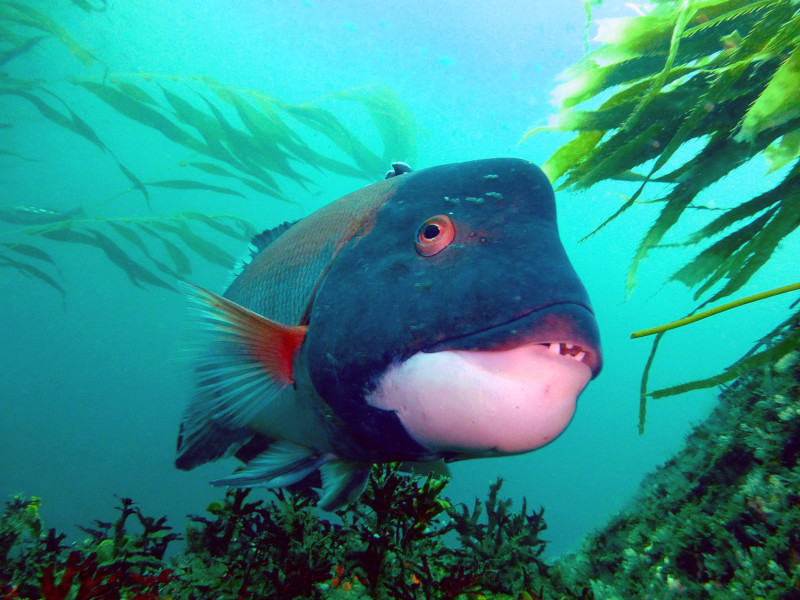California Sheephead Facts
- Firstly, the term California Sheephead serves as the common name of as single species of wrasse, in the Family Labridae. As unusual as the common name may seem to some, it remains much more easily pronounced than the scientific name of Semicossyphus pulcher. In addition to being more pronounceable, the common name also derives directly from its locality.
- However, neither of its names serves as the most notable thing about this unique species. That’s because it evolved one particular astounding physiological characteristic. That statement holds true due to the amazing fact that all individuals of this creature are born female. Further, this occurs at different ages for each individual, as a result of various factors.
- In addition, these differing factors primarily consist of various forms of either pressures or conditions in its environment, or both. Also, this remarkable physiological characteristic technically qualifies the California Sheephead as a protogynous hermaphrodite. Quite surprisingly to some people, it shares this trait with numerous species of plants, fish, and gastropods.
- Sadly, however, much like numerous species of all kinds around the world today, it now finds itself in danger. Officially, the IUCN presently list this fish as Vulnerable on its Red List of Threatened Species. Historically, commercial fishing posed the greatest threat the animal faced. However, the looming threat of ongoing climate change now threatens it, like many other species.
Related Articles
California Sheephead Physical Description
Yet another easily noted aspect of the amazing California Sheephead occurs in terms of its sheer physical appearance. That holds true due to the fact that this species displays a marked degree of the trait of sexual dimorphism. Furthermore, in this truly fascinating animal, that trait presents actually itself in terms of both color patterns and body shape.
Firstly, the males generally tend to acquire a larger body. Adult males can attain body lengths of as much as 3 ft (91 cm). Further, these same individuals sometimes reach weights of as much as 35 lb (16 kg). In color, these usually present a black tail and head. Meanwhile, the midriff shows an orange-red. It also displays bright red eyes, and has fleshy bumps on its forehead.
Meanwhile, the female California Sheephead attains a slightly smaller size. Furthermore, that same female presents a distinctly different color pattern than does the male of the species. That’s because females typically display primarily a dull pink color over most of the body. But, the underside of the body of the female, in contrast, commonly shows a dull white color. Yet both genders have large, protruding teeth.
- Kingdom: Animalia
- Phylum: Chordata
- Class: Actinopterygii
- Order: Labriformes
- Family: Labridae
- Genus: Semicossyphus
- Species: Semicossyphus pulcher
California Sheephead Distribution, Habitat, and Ecology
The incredible California Sheephead inhabits a highly restricted, and also quite specific habitat range. That’s partly because it only lives along the coastline. But it also holds true due to the limited extent of that range. That’s because it only appears from around Monterey Bay, California, in the United States, to the Gulf of California, Mexico, in North America.
Furthermore, the animal also has distinct preferences for the type of habitat it prefers. This occurs notwithstanding its highly limited zone of habitation. As a result, the great majority of specimens appear in areas consisting of either kelp forests or rocky reefs. However, a significantly smaller percentage of individuals choose to live in areas of loose sand.
Much like related species, the California Sheephead has a strictly carnivorous diet. While it will feed opportunistically, it nonetheless has distinct preferences in its choice of food. Primarily, the fish feeds on a wide variety of local species of sea urchins, mollusks, lobsters, and crabs. In addition, this animal forages for its food both individually and in groups.
Additionally, the fascinating fish has a lifespan of about 20 years, under favorable conditions. After mating, the female gives birth to numerous fertilized eggs. Further, she releases these into the water column to hatch, where they become planktonic larvae. The young have numerous predators. These include such species as harbor seals, sea lions, and various sea birds.
Species Sharing Its Range
Check out our other articles on 6 Fabulous European Lepidoptera, Tree Kangaroo, Mount Erebus, Adenium Flower Bonsai, Draco Volans, Desert Locust, Yunnan Golden Monkey

